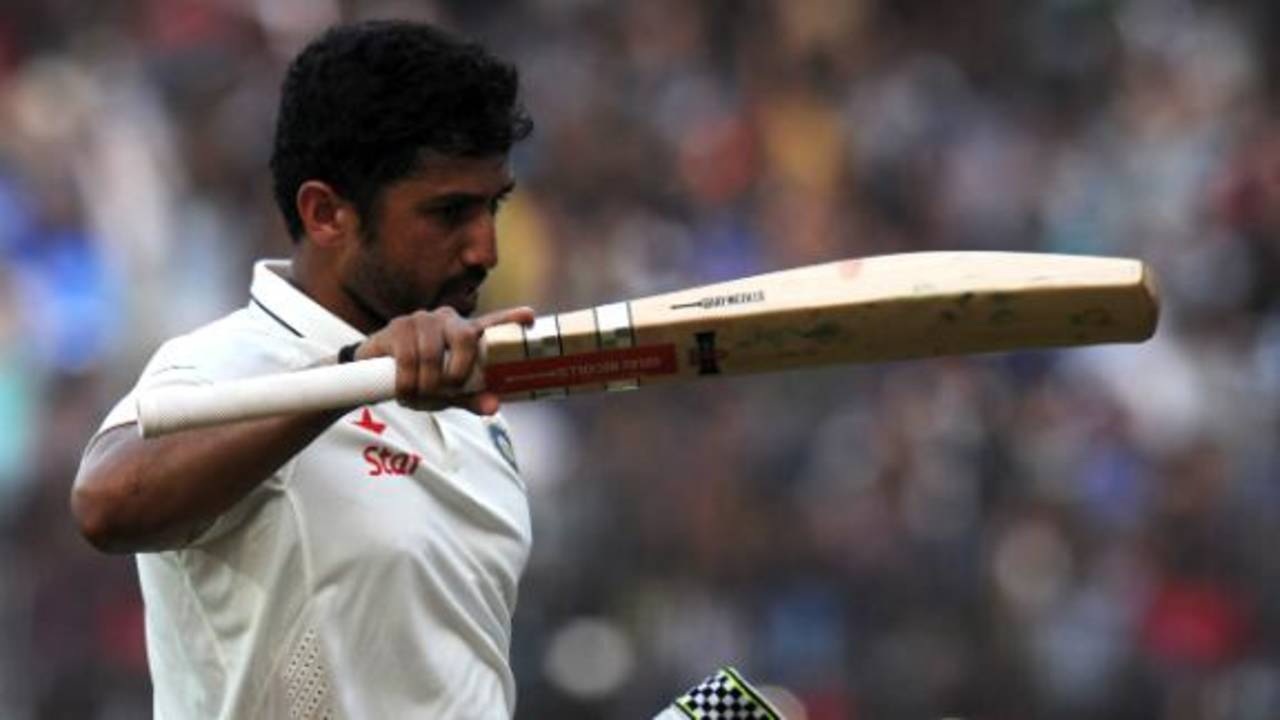A different method of attacking spin
Aakash Chopra breaks down why India's batsmen dominated and England's bowlers struggled in Chennai
Aakash Chopra
19-Dec-2016
Batting isn't always a side-on game
Karun Nair has shown the value of keeping the ball within his shoulders while playing spin. There's a lot of talk about how batsmen should always stay side-on but there's merit in opening up against spin on a turning pitch - it allows you to present the full face of the bat and also manoeuvre the turn. If you stay too side-on against a turning ball, you end up getting blocked with little room for manipulation in case the ball spins or bounces more. That's why you see batsmen opening their stance whenever they face a big-turning offspinner.
Karun Nair has shown the value of keeping the ball within his shoulders while playing spin. There's a lot of talk about how batsmen should always stay side-on but there's merit in opening up against spin on a turning pitch - it allows you to present the full face of the bat and also manoeuvre the turn. If you stay too side-on against a turning ball, you end up getting blocked with little room for manipulation in case the ball spins or bounces more. That's why you see batsmen opening their stance whenever they face a big-turning offspinner.
Karun Nair, KL Rahul and the sweep
Indian batsmen of the past have been great players of spin and their method had something in common - they did not use the sweep as a productive scoring option. Sachin Tendulkar, Rahul Dravid, Virender Sehwag, VVS Laxman and co. preferred using their feet to either get to the pitch of the ball or to use the depth of the crease and score off the back-foot. Even when they swept, it was mostly the paddle-sweep and an occasional regular sweep. Playing the reverse-sweep was simply not an option. Two young batsmen from Karnataka have swept with a lot of authority in Chennai and both had the audacity to attempt the reverse-sweep often too. Are they reflecting how the Indian batsmen of the future will play spinners? Both Rahul and Nair made their first-class debuts after the IPL, and while both have amassed thousands of first-class runs, they have done so without compromising their attacking instincts.
Indian batsmen of the past have been great players of spin and their method had something in common - they did not use the sweep as a productive scoring option. Sachin Tendulkar, Rahul Dravid, Virender Sehwag, VVS Laxman and co. preferred using their feet to either get to the pitch of the ball or to use the depth of the crease and score off the back-foot. Even when they swept, it was mostly the paddle-sweep and an occasional regular sweep. Playing the reverse-sweep was simply not an option. Two young batsmen from Karnataka have swept with a lot of authority in Chennai and both had the audacity to attempt the reverse-sweep often too. Are they reflecting how the Indian batsmen of the future will play spinners? Both Rahul and Nair made their first-class debuts after the IPL, and while both have amassed thousands of first-class runs, they have done so without compromising their attacking instincts.

Karun Nair's 360-degree batting might have something to do with his first-class debut coming after the advent of IPL•ESPNcricinfo Ltd
Club cricket v first-class cricket v Test cricket
The basic difference between the three levels is the frequency of bad balls. In club cricket, you get a couple of hittable balls every over because the quality of bowling isn't high quality. The lack of quality in batting means that every bad ball isn't punished either. In first-class cricket, the frequency of bad balls reduces radically and you perhaps get about one boundary ball in a couple of overs. In Test cricket, there will be longer periods without a boundary ball. In fact, good bowlers make it tough to even rotate strike and that leads to wickets. The England spinners were guilty of bowling one or more hittable balls every over in Chennai.
The basic difference between the three levels is the frequency of bad balls. In club cricket, you get a couple of hittable balls every over because the quality of bowling isn't high quality. The lack of quality in batting means that every bad ball isn't punished either. In first-class cricket, the frequency of bad balls reduces radically and you perhaps get about one boundary ball in a couple of overs. In Test cricket, there will be longer periods without a boundary ball. In fact, good bowlers make it tough to even rotate strike and that leads to wickets. The England spinners were guilty of bowling one or more hittable balls every over in Chennai.
The bouncer-trap against Jadeja
It was quite evident that England's seamers tried the bouncer-trap against Jadeja. Because the ball was new, it was a great plan for someone like Jadeja, who is not known for his defensive skills against short deliveries. While the plan was sound, the absence of a fielder at short-leg in the early part of his innings, didn't allow it to succeed. The moment they had a fielder at short-leg, Jadeja was forced to play shots and one could have easily gone to the fielder in the deep.
It was quite evident that England's seamers tried the bouncer-trap against Jadeja. Because the ball was new, it was a great plan for someone like Jadeja, who is not known for his defensive skills against short deliveries. While the plan was sound, the absence of a fielder at short-leg in the early part of his innings, didn't allow it to succeed. The moment they had a fielder at short-leg, Jadeja was forced to play shots and one could have easily gone to the fielder in the deep.
Aakash Chopra is the author of three books, the latest of which is The Insider: Decoding the craft of cricket. @cricketaakash
